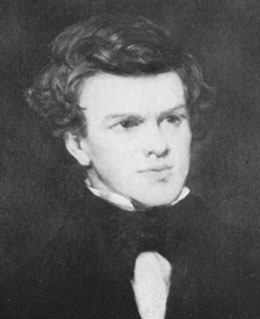| John Forster  Born: 2-Apr-1812 Born: 2-Apr-1812
Birthplace: Newcastle-upon-Tyne, England
Died: 2-Feb-1876
Location of death: London, England
Cause of death: unspecified
Gender: Male
Religion: Unitarian
Race or Ethnicity: White
Occupation: Author, Critic Nationality: England
Executive summary: Life of Charles Dickens English biographer and critic, born on the 2nd of April 1812 at Newcastle. His father, who was a Unitarian and belonged to the junior branch of a good Northumberland family, was a cattle dealer. After being well grounded in classics and mathematics at the grammar school of his native town, John Forster was sent in 1828 to Cambridge, but after only a month's residence he removed to London, where he attended classes at University College, and was entered at the Inner Temple. He devoted himself, however, chiefly to literary pursuits. He contributed to The True Sun, The Morning Chronicle and to The Examiner, for which he acted as literary and dramatic critic; and the influence of his powerful individuality soon made itself felt. His Lives of the Statesmen of the Commonwealth (1836-39) appeared partly in Lardner's Cyclopaedia. He published the work separately in 1840 with a Treatise on the Popular Progress in English History. Its merits obtained immediate recognition, and Forster became a prominent figure in that distinguished circle of literary men which included Bulwer, Talfourd, Albany, Fonblanque, Landor, Carlyle and Dickens. Forster is said to have been for some time engaged to Letitia Landon, but the engagement was broken off, and Miss Landon married George Maclean. In 1843 he was called to the bar but he never became a practicing lawyer. For some years he edited the Foreign Quarterly Review; in 1846, on the retirement of Charles Dickens, he took charge for some months of the Daily News; and from 1847 to 1856 he edited the Examiner. From 1836 onwards he contributed to the Edinburgh Quarterly and Foreign Quarterly Reviews a variety of articles, some of which were republished in two volumes of Biographical and Historical Essays (1858). In 1848 appeared his admirable Life and Times of Oliver Goldsmith (revised in 1854). Continuing his researches into English history under the early Stuarts, he published in 1860 the Arrest of the Five Members by Charles I -- A Chapter of English History rewritten, and The Debates on the Grand Remonstrance, with an Introductory Essay on English Freedom. These were followed by his Sir John Eliot: a Biography (1864), elaborated from one of his earlier studies for the Lives of Eminent British Statesmen. In 1868 appeared his Life of Landor, and, on the death of his friend Alexander Dyce, Forster undertook the publication of his third edition of Shakespeare. For several years he had been collecting materials for a life of Jonathan Swift, but he interrupted his studies in this direction to write his standard Life of Charles Dickens. He had long been intimate with the novelist, and it is by this work that John Forster is now chiefly remembered. The first volume appeared in 1872, and the biography was completed in 1874. Towards the close of 1875 the first volume of his Life of Swift was published; and he had made some progress in the preparation of the second at the time of his death on the 2nd of February 1876. In 1855 Forster had been appointed secretary to the lunacy commission, and from 1861 to 1872 he held the office of a commissioner in lunacy. His valuable collection of manuscripts, including the original copies of Charles Dickens's novels, together with his books and pictures, was bequeathed to South Kensington Museum.
Girlfriend: Letitia Landon (broken engagement)
University: Cambridge University (one monthin 1828)
University: University College London
Garrick Club
Requires Flash 7+ and Javascript.
Do you know something we don't?
Submit a correction or make a comment about this profile
Copyright ©2019 Soylent Communications
|